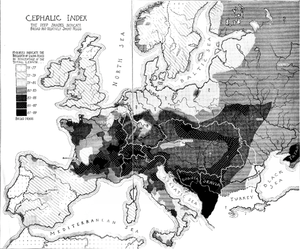
The Races of Europe (Ripley)
Encyclopedia

William Z. Ripley
William Zebina Ripley was an American economist, lecturer at Columbia University, professor of economics at MIT, professor of political economics at Harvard University, and racial theorist...
published The Races of Europe: A Sociological Study in 1899, which grew out of a series of lectures he gave at the Lowell Institute at Columbia in 1896. Ripley believed that race was critical to understanding human history, though his work afforded environmental and non-biological factors, such as traditions, a strong weight as well. He believed, as he wrote in the introduction to The Races of Europe, that:
- "Race, properly speaking, is responsible only for those peculiarities, mental or bodily, which are transmitted with constancy along the lines of direct physical descent from father to son. Many mental traits, aptitudes, or proclivities, on the other hand, which reappear persistently in successive populations may be derived from an entirely different source. They may have descended collaterally, along the lines of purely mental suggestion by virtue of mere social contact with preceding generations."
Ripley's book, written to help finance his children's education, became very-well respected in anthropology, renowned for its careful writing and careful compilation (and criticism) of the data of many other anthropologists in Europe and the United States. Ripley based his conclusions about race by correlating anthropometric
Anthropometry
Anthropometry refers to the measurement of the human individual...
data with geographical data, paying special attention to the use of the cephalic index
Cephalic index
Cephalic index is the ratio of the maximum width of the head multiplied by 100 divided by its maximum length ....
, which at the time was considered a well-established measure. From this and other socio-geographical factors, Ripley classified Europeans into three distinct races:
- Teutonic/Nordic — members of the northern race were long-skulled (or dolichocephalic), tall in stature, and possessed pale hair, eyes and skin.
- MediterraneanMediterranean raceThe Mediterranean race was one of the three sub-categories into which the Caucasian race and the people of Europe were divided by anthropologists in the late nineteenth and early twentieth centuries, following the publication of William Z. Ripley's book The Races of Europe...
— members of the southern race were long-skulled (or dolichocephalic), short/medium in stature, and possessed dark hair, eyes and skin. - AlpineAlpine raceThe Alpine race is an historical racial classification or sub-race of humans, considered a branch of the Caucasian race. The term is not commonly used today, but was popular in the early 20th century.-History:...
— members of the central race were round-skulled (or brachycephalic), stocky in stature, and possessed intermediate hair, eye and skin color.
Ripley's tripartite system of race put him at odds both with other scholars who insisted that there was only one European race, and those who insisted that there were dozens of European races (such as Joseph Deniker
Joseph Deniker
Joseph Deniker was a French naturalist and anthropologist, known primarily for his attempts to develop highly-detailed maps of race in Europe.- Life :...
, who Ripley saw as his chief rival). Ripley was the first American recipient of the Huxley Medal of the Royal Anthropological Institute in 1908 on account of his contributions to anthropology.
The Races of Europe, overall, became an influential book of the Progressive Era
Progressive Era
The Progressive Era in the United States was a period of social activism and political reform that flourished from the 1890s to the 1920s. One main goal of the Progressive movement was purification of government, as Progressives tried to eliminate corruption by exposing and undercutting political...
in the field of racial taxonomy. Ripley's tripartite system was especially championed by Madison Grant
Madison Grant
Madison Grant was an American lawyer, historian and physical anthropologist, known primarily for his work as a eugenicist and conservationist...
, who changed Ripley's "Teutonic" type into Grant's own Nordic type (taking the name, but little else, from Deniker), which he postulated as a master race
Master race
Master race was a phrase and concept originating in the slave-holding Southern US. The later phrase Herrenvolk , interpreted as 'master race', was a concept in Nazi ideology in which the Nordic peoples, one of the branches of what in the late-19th and early-20th century was called the Aryan race,...
. It is in this light that Ripley's work on race is usually remembered today, though little of Grant's ideology is present in Ripley's original work.
External links
- The Races of Europe: A Sociological Study (1899) by William Zebina Ripley at the Internet ArchiveInternet ArchiveThe Internet Archive is a non-profit digital library with the stated mission of "universal access to all knowledge". It offers permanent storage and access to collections of digitized materials, including websites, music, moving images, and nearly 3 million public domain books. The Internet Archive...

